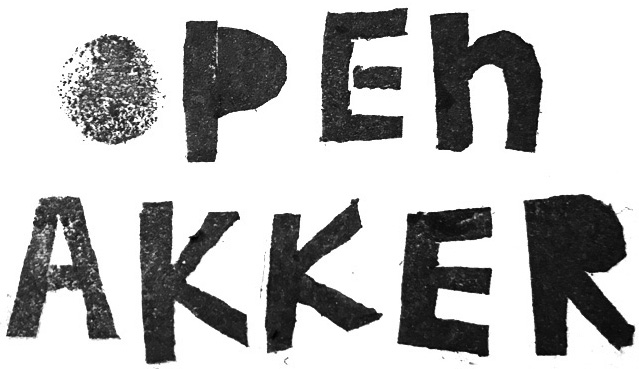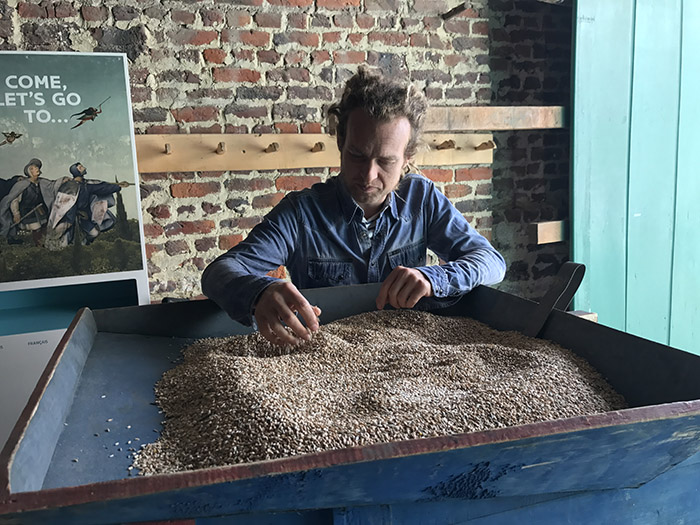
- - - - - - - - - - - - - - - - - - - - - - - - - - - - - - - - - - - - - - - - - - -
 
Open Akker is a multi-species gathering upon a small plot (of land) in the Pajottenland - the land where Pieter Bruegel the Elder portrayed peasants in The Harvesters and The Magpie on the Gallows. A rassemblement of farmers, seeds, soil, birds and trees flanked by a high-speed train and two roads in proximity to a watermill, form the scene of a series of actions. In intimate relation, this constellation enables the shift of a fallow field to a ‘new commons’ - a collectively farmed land dedicated to the propagation and multiplication of peasant seeds.
2018 - 2019
Season One
Open Akker was established in 2019 within the framework of Bruegel's Eye: Reconstructing the Landscape, an open-air exhibition in the Pajottenland in Dilbeek, Belgium. Fifteen contemporary artists and designers invited to look at the landscape through the eyes of Pieter Bruegel the Elder.
Open Akker was initiated by Futurefarmers as a durational public artwork enabling a slow, reflective process of repair, resilience and reflection on our habits of landuse. In collaboration with Livia Cahn, Tijs Boelens/De Groentelaar and Didier Demorcy/Li Mestère among others, our first season awakened this plot which is now a stage for things to come.
2020-
Season Two
Open Akker continues with new collaborators.
|


 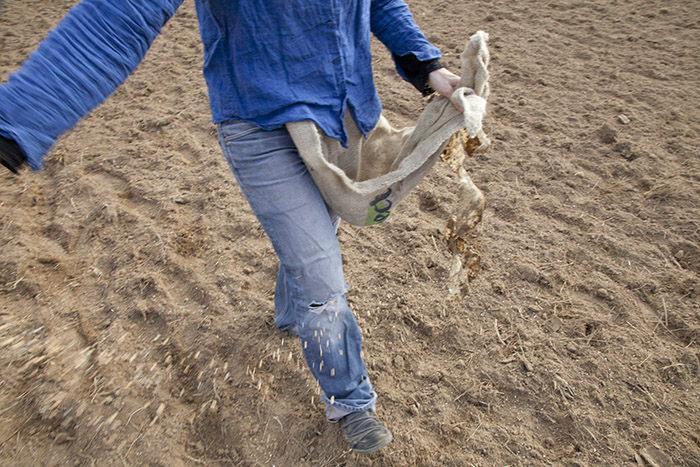
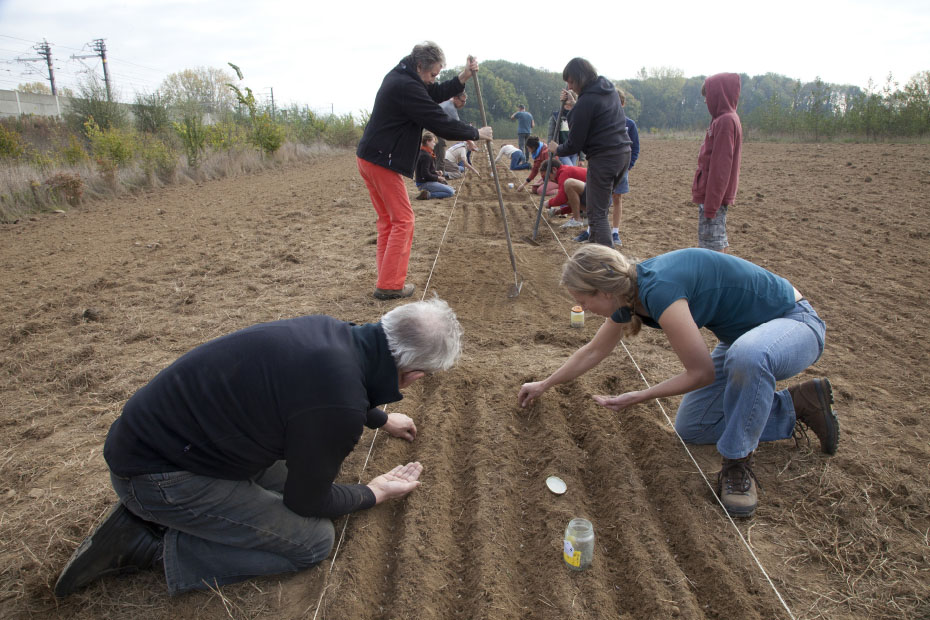
By hand and harrow, the soil of Open Akker is prepared - a stage is set. A “collection” of twenty-five distinct varieties of peasant grains sown seed by seed by the association Li Mestère. On the same field, a “peasant” mix of wheat and rye (masteluin) is wildly scattered by De Groentelaar to make flour for ‘resistance bread’ at the nearby mill. The plot resonates with different practices, temporalities and agencies by entangling millers with soils, seeds with late medieval paintings and observations with actions.
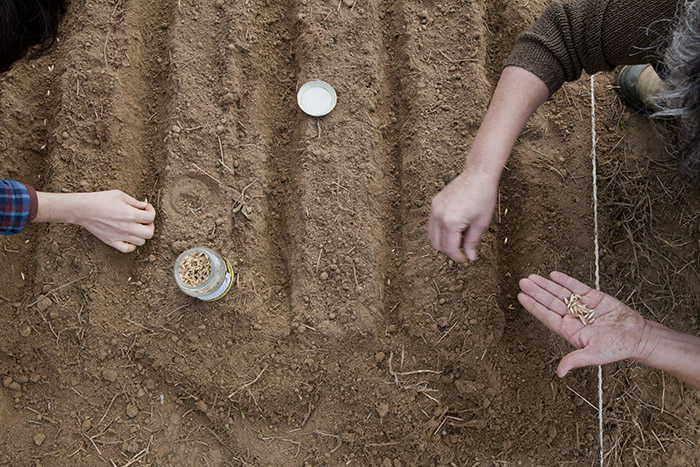
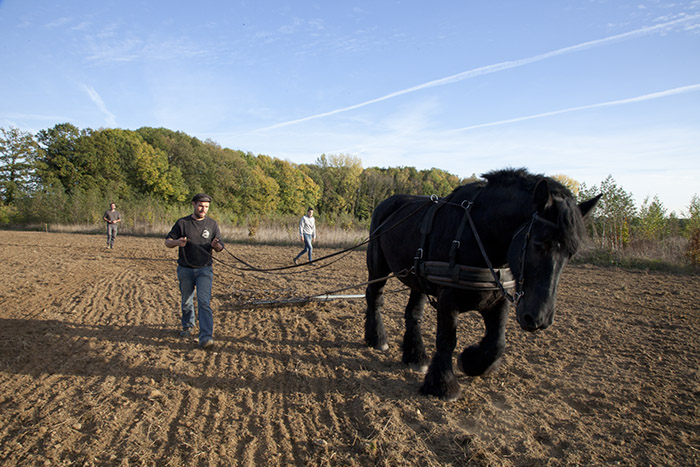
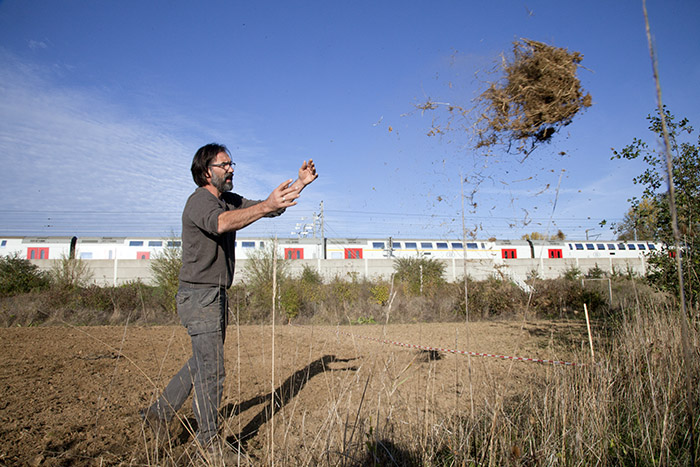

|

Derived from Old French paisent “local inhabitant” and Modern French from pais “country, region”
Late Latin pagensis “(inhabitant) of the district,” from Latin pagus “country or rural district” (see pagan).
| Depicted in the medieval scenes that Brueghel painted, the figure of the peasant is neither a romantic nor a timeless figure. Although the term has been used pejoratively, it has more recently been reclaimed by people who self-define as peasants. It is used to defend an agriculture that breaks with the conventions of large-scale agriculture to work in small-scale subsistence practices. Term peasant doesn’t necessarily refer to people who farm land, it can |
|
also encompass acts of taking care of land, of local landscapes, agro-ecological systems, traditions or living expressions inherited from our ancestors and passed on to our descendants, such as oral traditions, performing arts, social practices, rituals, festive events, knowledge and practices concerning nature and the universe or the knowledge and skills to tend to the land. |

Derived from the French manure, which comes from the Latin mixtellum Maslin
is a Medieval word for a crop of wheat and rye, grown together.
Based in the Pajottenland, organic, small-scale peasant farmer Tijs Boelens sowed a population of masteluin on the majority of plot at Open Akker. This experiment in sowing different cereal varieties together is based on archaebotanical findings of carbonised medieval grains in a nearby church in Lennik. A combination of rye and wheat varieties were sown by hand and harvested by combine harvester. In the middle ages cereals were often grown in such populations. Since the different cereal varieties have different tolerances to temperature, diseases, humidity or drought, the population of grains harvested year after year, changes as the varieties adapt to the soil and climatic conditions of a site. In response to external factors some cereals will do bet-ter than others. Such a mix makes it much less likely that a harvest fails completely. The variability within a mix of grains is increased by the possibility for cross-pollination among ryes. Farmers’ can also influence the selection by harvesting some and not other varieties to sow the following year. An going genetic and cultural selection are inherent to this masteluin sowing. |
|
The varieties sown in this part of the Open Akker were in part gathered through exchange with other farmers and in part salvaged from seed banks. Since most of them are not fixed varieties they are not listed in the European catalogue of seeds registered for sale by EU law. This list stipulates that varieties must be distinct, uniform, and stable. This is a long and expensive process that massively re-stricts the varieties grown in Europe. Since the mix does not consist of fixed varieties, it also cannot be sold. Precisely, the change-ability of population planted seeds poses a challenge to fixing varieties and patenting them. The percentage of each variety harvested is difficult to measure, ungridable. Even their slippery names, depend on regional dialects and traditions. Hard to identify, even harder to translate … a mix of at least sixteen varieties of grains were sown and include (in a mix of languages): Zeeuwse witte, Witte van Vlaan-deren, Limburgse rosse, Rouge d’automne barbu, Dattel, Gentil rosso, Blé d’ardenne, blé d’argonne, an unknown poulard variety, blé blanc d’alsace neissen, rouge du roc, Yommer nakkum, Sept épis (de Supiot Nicolas), Ommelander, Champagne Barbu, Jafayon (from Marc Vanoverschelde). |
|




 
- - - - - - - - - - - - - - - - - - - - - - - - - - - - - - - - - - - -
Finally, here is the procession of the peasants who have stepped out from your landscape. The sowers, the tillers, the gardeners, the millers, the beekeepers, the horses, the woodcutters and the magicians. Not one of us has forgotten you! We continue to exist with the gestures you gave us in the Pajottenland. We tell you with a wink that you might once have understood us, but now we live among new tricks.
- - - - - - - - - - - - - - - - - - - - - - - - - - - - - - - - - - - -
|
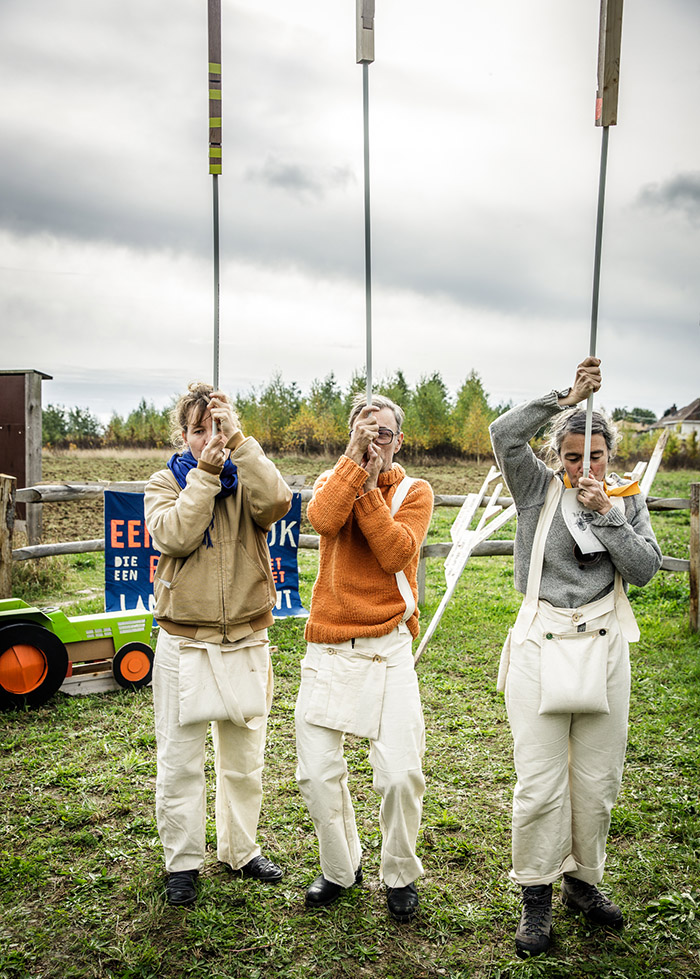

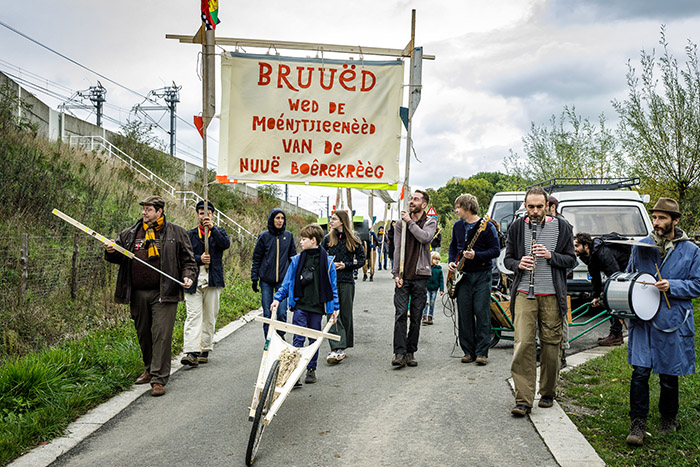
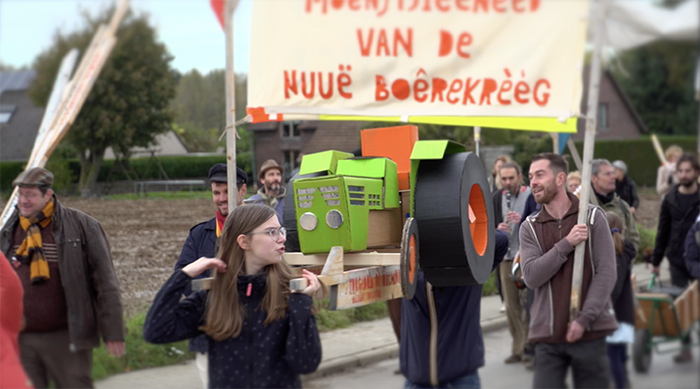
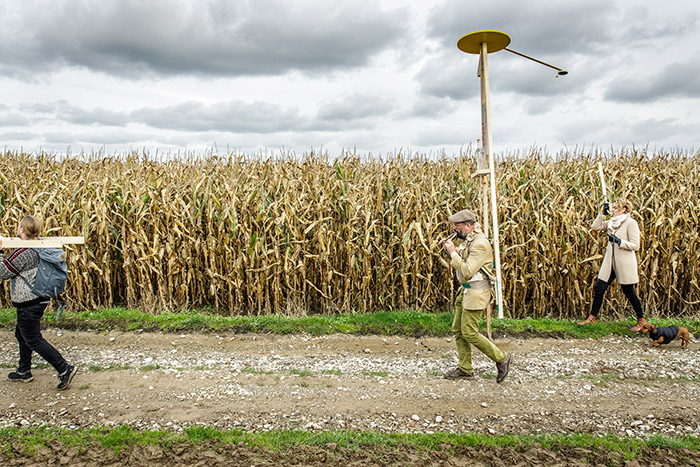

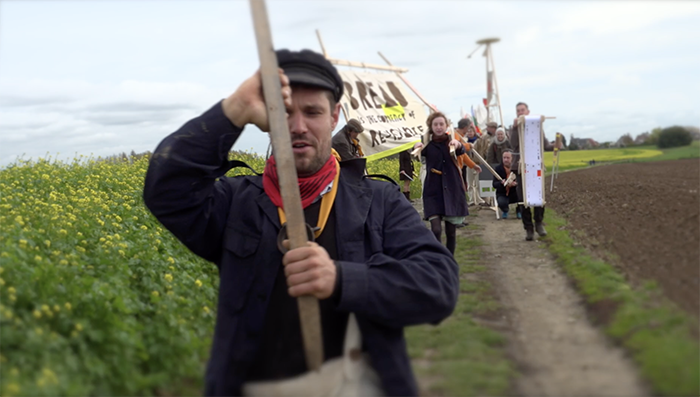
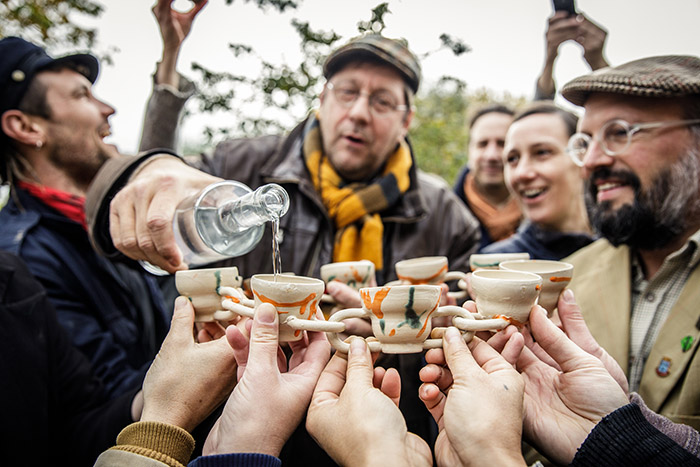
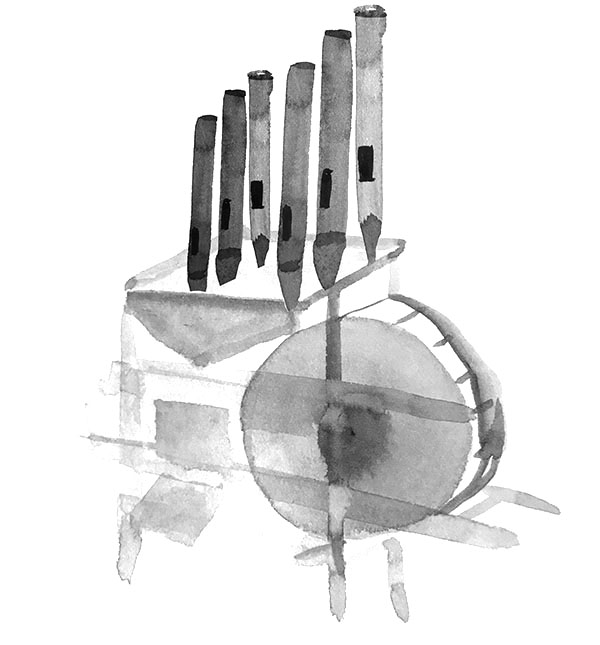 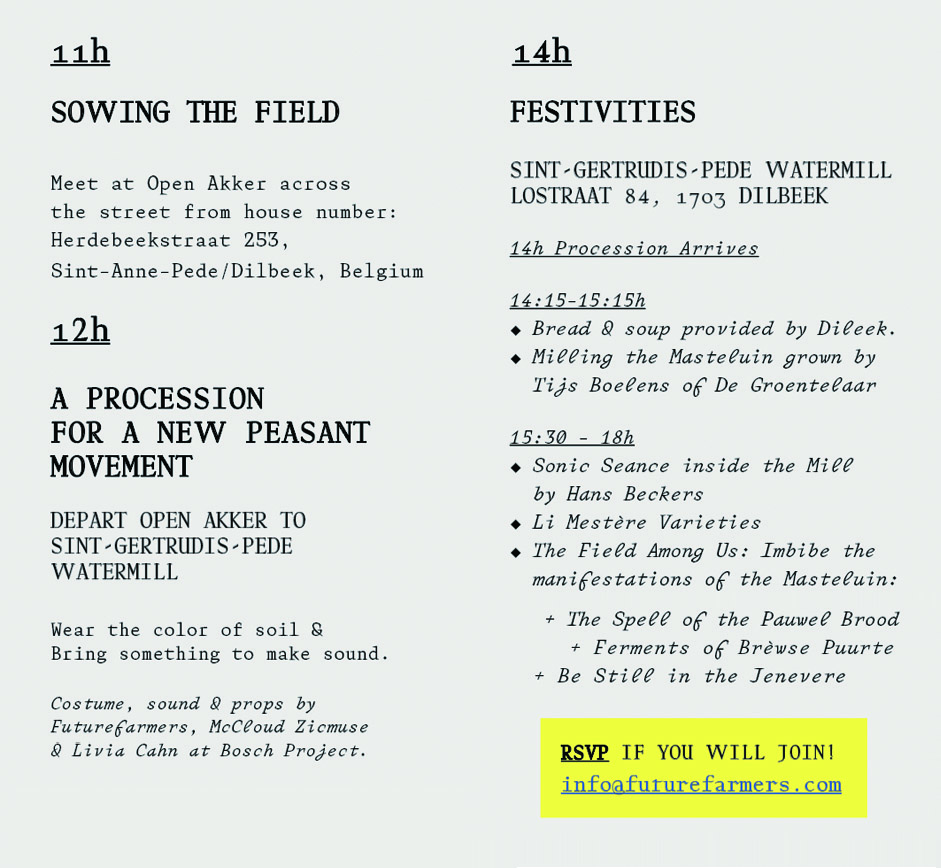
*Costume and props made during periodic happenings by Futurefarmers, McCloud Zicmuse and Livia Cahn under the hosting care of Bosch Project in Brussels, Belgium.
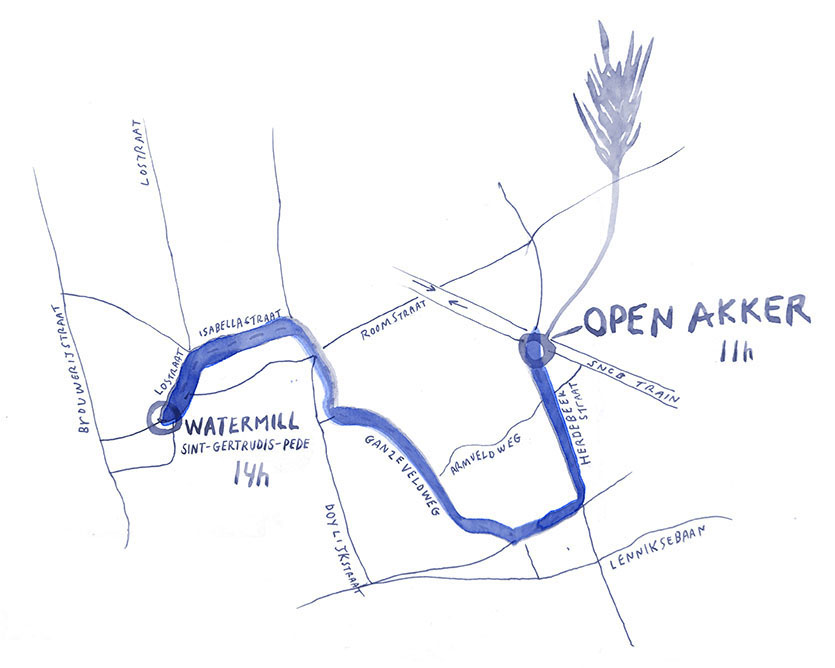
|


|
Open Akker is a constellation of farmers, artists and anthropologists, among others who are working towards the healing of a plot of land to be communally farmed in Dilbeek, Belgium:
De Groentelaar
Farmers/Actvists
Gent, Belgium
De Groentelaar is a small farm run by Tijs Boelens and Sander Van Haver who are working to re-establish a mix of grains once grown in this region in the time of Bruegel.
Li Mestère
Li Mestère is an association which gathers farmers, millers, bakers, connoisseurs, gardeners, consumers, scientists and researchers around the question of cereals. The association has members living in Wallonia, Flanders and Brussels; and collaborates with different associations, networks and scientific laboratories from Europe involved in Participatory Plant Breeding.
In the alliance between farmer and seed: the kind of peasant farmer that the “peasant seeds” invokes is a farmer who sees the absurdity of big scale production. Who doesn't accept that the value of their grains would be fixed by the ona and only global market of grain prices. Being a peasant seed farmer is not in anyway a step back in time, to hark back to a romantic figure of a past peasant. It does not ignore the long history of grain selection, it navigates through this long history and crafts with the grains, tools, questions and preoccupations that animate them. A practice that defends a relationship with the land today - in the now, the now and the now.
-
Didier Demorcy, Li Mestère
Futurefarmers
Artist/Architect
San Francisco, USA / Gent, Belgium
Futurefarmers is the lead artists group of Open Akker. Futureefarmers are a group of artists, activists, scientists, farmers, and architects who work together to propose alternatives to the social, political, and environmental organization of space. Founded in 1995, Futurefarmers design studio serves as a platform to support art projects, an artist in residence program, and the research of its members. Futurefarmers use various media to deconstruct systems, visualize and understand their intrinsic logics, and offer more sustainable alternatives. Such systems may involve food policy, public transportation, or education.
Livia Cahn
Notebook / Social Anthropologist
Brussels, Belgium
Livia Cahn is trained in urban anthropology and currently based in Brussels. Here she is a researcher, activist and gardener who works with and writes on soils and questions relating to land use. Co-author of “Terres des Villes, enquêtes potagères de Bruxelles au premières saisons du 21ième siècle” (éditions de l’éclat, 2017) and a series of picture essays on urban soils, she is a co-initiator of the seminar group: Ecologies de Bruxelles.
+ Thank you to Dilbeek and Bruegel's Eye for supporting the first year sowing and Harvest.
|

- - - - - - - - - - - - - - - - - - - - - - - - - - - - - - - - - - -
CAST
Bakers / Millers
-
Tom De Vuyst, Yves Sterckx and Jos Appelmans
Sound
-
Hans Beckers
Watermill
-
Sint-Gertrudis-Pede
Cultivator/Harrower
-
Fred van Denbosch
Horse
-
Vatje
Dog
-
Carla
Horse Tender
-
Steven Fillet
Three Release Doves (white pigeons)
Costume/Props
-
Futurefarmers
Zicmuse/McCloud
The Road
-
Herdebeekstraat
The Tractors
-
The Train
_
NMBS
Ferments
-
Brèwse Puurte
Fontographer
-
Eva De Moor
Soil, Seeds, Air, Sunshine, Rain and Ladybugs
|


Open Akker is located across the street from house number
Herdebeekstraat 253
in Sint-Anna-Pede in 1701 Dilbeek, Belgium
50.826649, 4.234424
MAP

Sint-Gertrudis-Pede Watermill
Lostraat 84, 1703 Dilbeek
Sint-Anna-Pede in Dilbeek, Belgium
MAP
Dilbeek 1703
50.825278, 4.210917

BY TRAIN
Stations in the area: Dilbeek (5 km) Sint-Martens-Bodegem (5 km) Brussel Zuid (7,5 km)
www.nmbs.be
- - - - - - - - - - - - - - - - - - - - - - - - - - - - - - - - - - - - - - - - - BY BUS
Bus stop De Lijn: Sint-Anna-Pede Kerk Lijnbus 118
(Brussel Midi > Sint-Anna-Pede > Schepdaal)
Saturday & Sunday this line is temporarily extended to Kasteel van Gaasbeek (6/4 - 31/10/2019) Metro 5 (Brussels Central Station > Anderlecht, Sint-Guido), connecting bus of De Lijn 118 Lijnbus 128 (Brussel North > Bettendries),
14 min. walk to Sint-Anna-Pede/OPEN AKKER
www.delijn.be
- - - - - - - - - - - - - - - - - - - - - - - - - - - - - - - - - - - - - - - - -
BY BIKE
Your own bike
on the train Stations in the area: Dilbeek (5 km) Sint-Martens-Bodegem (5 km) Brussel Midi (7,5 km) www.nmbs.be
Your own bike on the car
Parking area CC Westrand (4 km) Kamerijklaan 46 1700 Dilbeek
Rent a bike
in Brussels 30 min. from the centre of Brussels to Sint-Anna-Pede www.villo.be
billy.bike (electric)
- - - - - - - - - - - - - - - - - - - - - - - - - - - - - - - - - - - - - - - - -
BY CAR
Parking spaces in Sint-Anna-Pede itself are limited.
Before setting off, please consult the parking map with all parking possibilities in the general area.
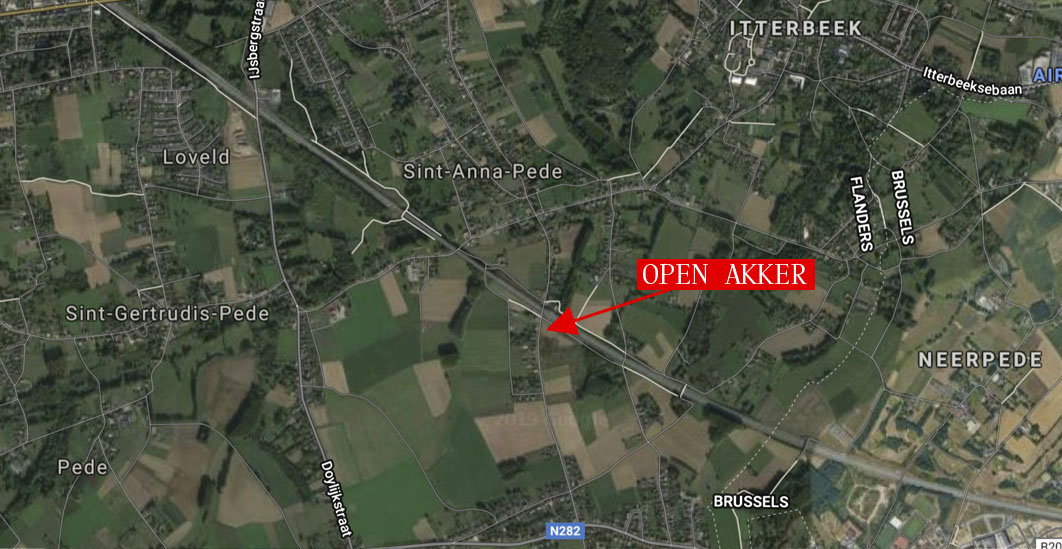
|

|


